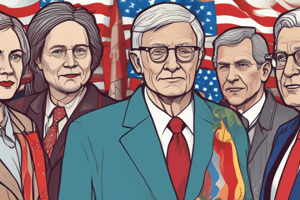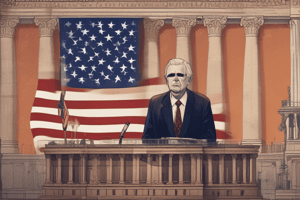Podcast
Questions and Answers
What was a key aspect of the conservative coalition in the mid-1960s?
What was a key aspect of the conservative coalition in the mid-1960s?
- An alliance of labor unions and liberal Democrats
- A group of anti-war protesters and feminists
- An alliance of business leaders, middle-class voters, disaffected Democrats, and fundamentalist Christian groups (correct)
- A coalition of environmentalists and civil rights activists
What was the main goal of the Moral Majority?
What was the main goal of the Moral Majority?
- To restore traditional moral values and condemn liberal attitudes and behaviors (correct)
- To promote liberal attitudes and behaviors
- To support the Equal Rights Amendment
- To increase government funding for social programs
Who founded the Moral Majority?
Who founded the Moral Majority?
- Ronald Reagan
- Pat Robertson
- Gerald Ford
- Jerry Falwell (correct)
What was the outcome of the 1980 presidential election?
What was the outcome of the 1980 presidential election?
What was a key issue that conservatives opposed in the 1970s?
What was a key issue that conservatives opposed in the 1970s?
Study Notes
Conservative Movement in the 1960s-1980s
- Since 1964, conservatives have argued for more freedom from the federal government for state governments, businesses, and individuals.
- By 1980, government spending on entitlement programs had reached almost $300 billion annually, causing resentment among taxpayers due to reports of fraudulent benefits.
Civil Rights and Government Policies
- The Civil Rights Act of 1964 was intended to end racial discrimination, but over time, judicial decisions and government regulations broadened its reach, leading to frustration and skepticism among some.
- While many rejected separate schools as unfair and unequal, few supported busing children long distances to achieve a fixed ratio of black and white students.
Goals of the Conservative Movement
- The conservative movement aimed to shrink the size and spending of the federal government, promote family and patriotic values, stimulate business by reducing government regulations and lowering taxes, and strengthen national defense.
The New Right
- The New Right emerged in the 1970s as a grassroots movement focused on controversial social issues, such as opposing abortion, blocking the ERA, evading court-ordered busing, and promoting a return to school prayer.
- The New Right criticized affirmative action as reverse discrimination and viewed liberal positions on affirmative action and other issues as an assault on traditional values.
The Conservative Coalition
- The conservative movement grew in strength in the mid-1960s, leading to the formation of the Conservative Coalition, an alliance of business leaders, middle-class voters, disaffected Democrats, and fundamentalist Christian groups.
- Conservative think tanks like the American Enterprise Institute and the Heritage Foundation were established to develop conservative policies and principles that would appeal to a majority of voters.
Moral Majority
- The Moral Majority, an organization of mostly evangelical and fundamentalist Christians, played a key role in growing the strength of the conservative coalition.
- Influential televangelists like Jerry Falwell and Pat Robertson condemned liberal attitudes and behaviors, arguing for the restoration of traditional moral values.
- The Moral Majority hoped to reduce the divorce rate and the number of out-of-wedlock births by promoting traditional "family values" and encouraging individual responsibility.
Conservatives Win Political Power
- In 1976, Ronald Reagan lost the Republican nomination to Gerald Ford in a closely contested race.
- In 1980, Reagan won the nomination with George H.W. Bush as his running mate, defeating President Carter and VP Mondale in the general election.
Studying That Suits You
Use AI to generate personalized quizzes and flashcards to suit your learning preferences.
Description
This quiz covers the political and social changes in the United States from the 1960s to the 1980s, including the rise of conservatism, government spending on entitlement programs, and the Civil Rights Act of 1964.





